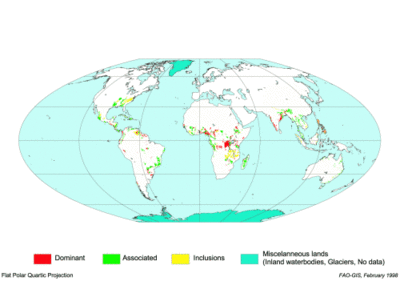Earth:Nitisol
Nitisol, in the World Reference Base for Soil Resources (WRB), is a deep, red, well-drained soil with a clay content of at least 30% and a polyhedral structure or a blocky structure, breaking into a polyhedral or a flat-edged structure. The soil aggregates show pressure faces. Nitisols correlate with the kandic alfisols, ultisols and inceptisols of the USDA soil taxonomy.[1][2]
These soils are found in the tropics and subtropics; there are extensive areas of them in the tropical highlands of Ethiopia, Kenya, Democratic Republic of the Congo and Cameroon. Nitisols form from fine-textured material weathered from intermediate to basic parent rock and kaolinite, halloysite and iron oxides dominate their clay mineralogy.
Nitisols are technically defined by a significant accumulation of clay (30 percent or more by mass and extending as much as 150 cm [5 feet] below the surface) and by a blocky aggregate structure. Iron oxides and high-water content are believed to play important roles in creating the soil structure. Nitisols are also strongly influenced by biological activity, resulting in a homogenization of the upper portion of the soil profile. These soils are related to the Alfisol and Inceptisol orders of the United States . Soil Taxonomy. Related FAO soil groups originating in tropical climates and also containing layers with clay accumulations are Acrisols and Lixisols.[3]
See also
References
- ↑ Delvaux, B.; Brahy, V.. "Mineral Soils conditioned by a Wet (Sub)Tropical Climate". FAO. http://www.fao.org/docrep/003/y1899e/y1899e08a.htm.
- ↑ "Major Soils of the World. ISRIC Wageningen, The Netherlands, 2001". https://www.isric.org/sites/default/files/major_soils_of_the_world/set6/nt/nitisol.pdf.
- ↑ "Nitisol | Soil Classification, Clay Content & Nutrient Retention | Britannica" (in en). https://www.britannica.com/science/Nitisol.
Further reading
- IUSS Working Group WRB: World Reference Base for Soil Resources, fourth edition. International Union of Soil Sciences, Vienna 2022. ISBN:979-8-9862451-1-9 ([1]).
- W. Zech, P. Schad, G. Hintermaier-Erhard: Soils of the World. Springer, Berlin 2022, Chapter 9.3.2. ISBN:978-3-540-30460-9
External links
- profile photos (with classification) WRB homepage
- profile photos (with classification) IUSS World of Soils
 |


